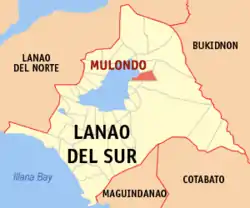Mulondo, Lanao del Sur
Mulondo, officially the Municipality of Mulondo (Maranao: Inged a Mulondo; Tagalog: Bayan ng Mulondo), is a 3rd class municipality in the province of Lanao del Sur, Philippines. According to the 2015 census, it has a population of 16,067 people. [3]
Mulondo | |
|---|---|
| Municipality of Mulondo | |
 Map of Lanao del Sur with Mulondo highlighted | |
OpenStreetMap 
| |
.svg.png.webp) Mulondo Location within the Philippines | |
| Coordinates: 7°56′N 124°23′E | |
| Country | |
| Region | Bangsamoro Autonomous Region in Muslim Mindanao (BARMM) |
| Province | Lanao del Sur |
| District | 1st District |
| Barangays | 26 (see Barangays) |
| Government | |
| • Type | Sangguniang Bayan |
| • Mayor | Nihara M. Panandigan |
| • Vice Mayor | Salic M. Didato |
| • Representative | Ansaruddin Abdul Malik A. Adiong |
| • Electorate | 13,629 voters (2019) |
| Area | |
| • Total | 458.67 km2 (177.09 sq mi) |
| Elevation | 712 m (2,336 ft) |
| Population | |
| • Total | 16,067 |
| • Density | 35/km2 (91/sq mi) |
| • Households | 1,161 |
| Economy | |
| • Income class | 3rd municipal income class |
| • Poverty incidence | 65.86% (2015)[4] |
| • Revenue | ₱98,035,561.13 (2016) |
| Time zone | UTC+8 (PST) |
| ZIP code | 9702 |
| PSGC | |
| IDD : area code | +63 (0)63 |
| Climate type | tropical climate |
| Native languages | Maranao Tagalog |
Etymology
Its name is derived from the Maranao dialect, which means "People of Lake"
Geography
Formerly known as Bato Intan, it is geographically situated east from Masiu, one of the four (4) Principalities of Lanao (Pangampong A Ranao), the governing bodies of the Lanao Sultanate. Strategically located in the 1st District of Lanao del Sur where it is partially urban. It is the birth place of Incumbent Councilor Abdul Jabbar Macabantog.
Barangays
Mulondo is politically subdivided into 26 barangays.
- Bangon
- Bubonga Guilopa
- Buadi-Abala
- Buadi-Bayawa
- Buadi-Insuba
- Bubong
- Cabasaran
- Cairatan
- Cormatan
- Poblacion (Dado)
- Dalama
- Dansalan
- Dimarao
- Guilopa
- Ilian
- Kitambugun
- Lama (Bagoaingud)
- Lilod
- Lilod Raybalai
- Lumbaca Ingud
- Lumbac (Lumbac Bubong)
- Madaya
- Pindolonan
- Salipongan
- Sugan
- Bagoaingud
Climate
| Climate data for Mulondo, Lanao del Sur | |||||||||||||
|---|---|---|---|---|---|---|---|---|---|---|---|---|---|
| Month | Jan | Feb | Mar | Apr | May | Jun | Jul | Aug | Sep | Oct | Nov | Dec | Year |
| Average high °C (°F) | 24 (75) |
24 (75) |
25 (77) |
26 (79) |
26 (79) |
25 (77) |
25 (77) |
25 (77) |
25 (77) |
25 (77) |
25 (77) |
25 (77) |
25 (77) |
| Average low °C (°F) | 20 (68) |
20 (68) |
20 (68) |
20 (68) |
21 (70) |
21 (70) |
20 (68) |
20 (68) |
20 (68) |
20 (68) |
20 (68) |
20 (68) |
20 (68) |
| Average precipitation mm (inches) | 159 (6.3) |
143 (5.6) |
166 (6.5) |
183 (7.2) |
357 (14.1) |
414 (16.3) |
333 (13.1) |
309 (12.2) |
289 (11.4) |
285 (11.2) |
253 (10.0) |
166 (6.5) |
3,057 (120.4) |
| Average rainy days | 18.4 | 17.2 | 20.6 | 23.4 | 29.3 | 29.2 | 29.9 | 29.4 | 27.7 | 28.7 | 25.5 | 19.9 | 299.2 |
| Source: Meteoblue (modeled/calculated data, not measured locally)[5] | |||||||||||||
Demographics
|
| |||||||||||||||||||||||||||||||||||||||||||||
| Source: Philippine Statistics Authority [3] [6] [7][8] | ||||||||||||||||||||||||||||||||||||||||||||||
References
- Municipality of Mulondo | (DILG)
- "Province: Lanao del Sur". PSGC Interactive. Quezon City, Philippines: Philippine Statistics Authority. Retrieved 12 November 2016.
- Census of Population (2015). "ARMM – Autonomous Region in Muslim Mindanao". Total Population by Province, City, Municipality and Barangay. PSA. Retrieved 20 June 2016.
- "PSA releases the 2015 Municipal and City Level Poverty Estimates". Quezon City, Philippines. Retrieved 12 October 2019.
- "Mulondo, Lanao del Sur : Average Temperatures and Rainfall". Meteoblue. Retrieved 27 January 2019.
- Census of Population and Housing (2010). "ARMM – Autonomous Region in Muslim Mindanao". Total Population by Province, City, Municipality and Barangay. NSO. Retrieved 29 June 2016.
- Censuses of Population (1903–2007). "ARMM – Autonomous Region in Muslim Mindanao". Table 1. Population Enumerated in Various Censuses by Province/Highly Urbanized City: 1903 to 2007. NSO.
- "Province of Lanao del Sur". Municipality Population Data. Local Water Utilities Administration Research Division. Retrieved 17 December 2016.
External links
This article is issued from Wikipedia. The text is licensed under Creative Commons - Attribution - Sharealike. Additional terms may apply for the media files.